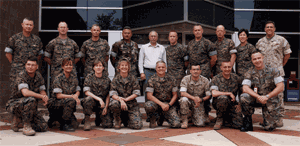When it comes to personnel administration, the special needs of government offices can make it difficult to implement standard, commercial human resources systems. This is particularly true for branches of the military.Defense Department HR officials not only manage widely dispersed forces, they also track unique workflows, complex roles and permissions, rank assignments, pay grades, temporary reassignments and more.Combine this complexity with sprawling legacy systems, and many government HR departments find it easier to create their own HR systems than to install commercial ones that usually need to be customized.That was the situation faced by the Manpower & Reserve Affairs office at the Marine Corps Base at Quantico, Va.The office developed an ongoing program called the Total Force Administration System, that will be rolling out in stages over the next few years'with updates and improvements anticipated through 2011.'We did not find a software vendor with a product ready to go,' said Maj. Steven A. Simmons, TFAS project officer. 'They all needed major customization to meet our requirements.'Marine Online (MOL), the Web application for the TFAS program, is set to start this fall. It lets Marines access much of their own personnel data and update selected items. It also gives company commanders and unit leaders access to personnel data and processes for the Marines who are in that company.TFAS was developed and implemented by a project team of acquisition officers from the Marine Corps Systems Command, functional managers from Marine Manpower and Reserve Affairs at Quantico and software engineers from the Defense Finance and Accounting Service's Technology Services Organization in Kansas City, Mo.In the mid-1990s, Marine personnel administrators, like leaders in many government offices, were stuck with shuffling a lot of paper and doing redundant data entry into multiple systems.'To get information in and out of the system, we needed trained administrators who knew special codes,' Simmons said.[IMGCAP(2)] 'Marines themselves and unit leaders didn't have direct access to information. Getting something as simple as an alphabetical roster of names and ranks was complicated because you needed to get someone in the personnel center to help you retrieve it. Slightly more complex things like promotions or transferring Marines between units could take days or weeks,' he said.One important requirement was that the Marines didn't want to have to define, ahead of time, the route each transaction takes, person-to-person. Instead they wanted that decision to be made at run time.In the Marine Online system, transactions can be routed different ways, depending on a flexible set of rules. For example, a specific MOL user, perhaps a captain, can be assigned leave approval authority for members of only one company. Further, the captain can grant 'recommend' authority to subordinate platoon commanders for Marines in a specific platoon.The creation of a Web front end to the personnel system gave Marines and their commanders instant access to personnel information.The Java2 Enterprise Edition Web application that runs Marine Online requires no special application on client machines, just a browser.Extensible Markup Language and Web services are used to bridge the Web application to the Marine Corps Total Force System (MCTFS)'a legacy IBM Corp. mainframe system.Some of the system's information is sent to an Oracle9i relational database that enforces rules and collects data that doesn't need to be kept in the main database of personnel information. This includes, for example, leave dates or temporary assignments.Because every unit has a commanding officer with subordinates, a typical setup for the Marine Online system is to start at the top of the pyramid. Each commanding officer can grant permissions by task.'We pull the data together in the application layer from the read-only source, which is a daily snapshot of the MCTFS mainframe data,' Simmons said.'Transactional data is then added from the Oracle database and presented to the user,' he said. 'If input from the user affects the data in the mainframe, it generates an XML document via the Web server to update it. If the data is transactional and not related to MCTFS, the system writes it back to the relational database.'Apply this to the hundreds of personnel processes handled by the Marine Corps each day, and you can get an idea of the number of hours saved via this automated system.The goal is to slowly expand the system over the next few years by incorporating travel plans, orders and awards, Simmons said. There's even a plan to track where people are day to day'in or out of the office, on the road, or on a battlefield.Marine Online now has more than 200,000 registered users, with plans to grow to 500,000, incorporating all Marines'active duty, Reserves, retirees and civilian employees.The system's average Web server traffic is about 300 concurrent users, ramping toward 1,000'and is configured to support 10,000 concurrent users with the ability to scale beyond that.Connectivity is made over the Internet but with Secure Sockets Layer connections and password-controlled access. The infrastructure conforms to the Defense Department's Joint Technology Architecture standards, and the production environment is standards-based, with open products and components such as the Oracle Corp. database, Lightweight Directory Access Protocol, IBM's MQSeries software and J2EE.'I truly believe we are on the cusp of a major revolution in how the Marine Corps handles and deals with its manpower processes,' Simmons said.'We are going to save incredible amounts of time, money and effort in doing these things. This will free up our resources for our primary mission, which is fighting our country's wars,' he said.
Project team members at the Marine Corps Base in Quantico, Va., worked with software engineers in Kansas City, Mo., in developing TFAS.
The Corps is 'on the cusp of a major revolution' in how it handles manpower processes.
'Maj. Steven A. Simmons
Too much customizationGet it fastAdding more usersShawn P. McCarthy is president of an information services development company. Send him e-mail at internaut@diagonalmediagroup.com. 







